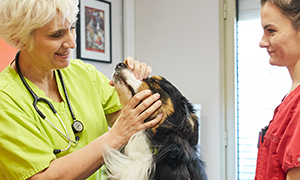Why does your dog have bad breath?

Is your pet at risk?
Dental Disease - a common problem
Dental diseases are becoming more common in pets, with up to 85 per cent of animals aged three years and over now affected. Does your dog or cat have halitosis (bad breath)? This is often the first sign of a problem - but it can be prevented.
As with human teeth, residual food, bacteria and calcium deposits form plaque and tartar on pet’s teeth, with painful and sometimes serious results.
Failure to address the problem can result in bacteria being carried into the animal’s bloodstream, resulting in severe or even fatal complications. Your pet's dental care is an important part of their health.
Signs of dental disease
 There are numerous dental disease symptoms in both dogs and cats.
There are numerous dental disease symptoms in both dogs and cats.
- Drooling
- Bad breath
- Reluctance or inability to eat
- Lip smacking
- Pawing at the mouth
- Mouth hanging open, with tongue protruding
- The animal using one side of the mouth, and dropping food while chewing
- Rejection of hard or crunchy foods in preference for tinned or soft food
- Poor appetite
- A build-up of plaque and stains on teeth
- Redness, swelling and bleeding of the gums
How to prevent dental disease
There are a number of ways to prevent dental disease by a combination of
- Diet – provide pets with regular access to special dental treats, chews and dental diets.
- Dental water additives
- Regular brushing with pet toothpastes and tooth brushes
- Rinsing with special gels
Don't risk the health of your pet - get a dental checkup at your next vet visit, and be sure to look after your pet's teeth.
